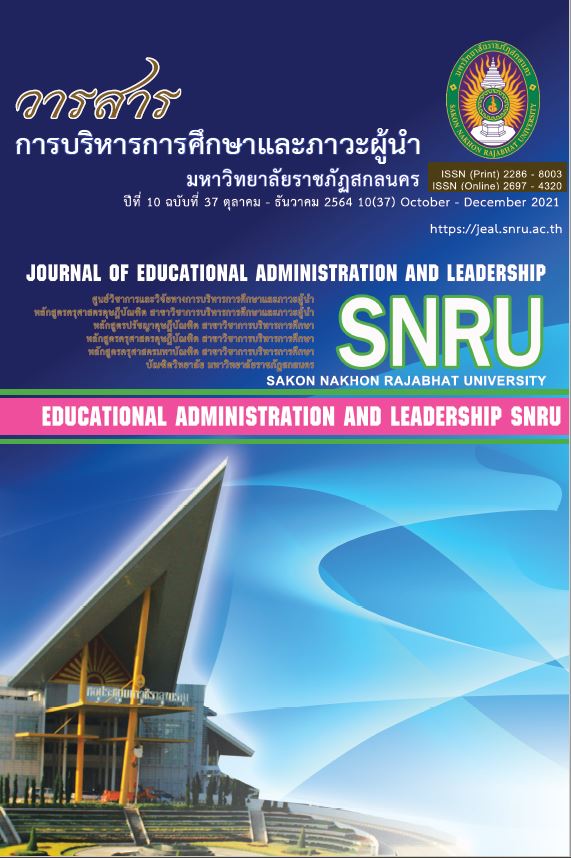

ความสัมพันธ์ระหว่างภาวะผู้นำทางวิชาการของผู้บริหารสถานศึกษากับการเป็นชุมชนแห่งการเรียนรู้ทางวิชาชีพของโรงเรียน สังกัดสำนักงานเขตพื้นที่การศึกษาประถมศึกษาสกลนคร เขต 2
The Relationship between Instructional Leadership of School Administrators and Professional Learning Community of Schools under the Sakon Nakhon Primary Educational Service Area Office 2
ผู้แต่ง
ปานหทัย ธรรมรัตน์, ไชยา ภาวะบุตร, ชรินดา พิมพบุตร
Author
Parnhathai Thammarat, Chaiya Pawabutra, Charinda Pimpabud
บทคัดย่อ
การวิจัยครั้งนี้มีความมุ่งหมายเพื่อศึกษา เปรียบเทียบ และหาความสัมพันธ์ ระหว่างภาวะผู้นำทางวิชาการของผู้บริหารสถานศึกษากับการเป็นชุมชนแห่งการเรียนรู้ของโรงเรียน สังกัดสำนักงานเขตพื้นที่การศึกษาประถมศึกษาสกลนคร เขต 2 และหาแนวทางพัฒนาภาวะผู้นำทางวิชาการของผู้บริหารสถานศึกษากับการเป็นชุมชนแห่งการเรียนรู้ กลุ่มตัวอย่างใช้ในการวิจัยในครั้งนี้ ได้แก่ ผู้บริหารสถานศึกษาและครูผู้สอน โรงเรียนในสังกัดสำนักงานเขตพื้นที่การศึกษาประถมศึกษาสกลนคร เขต 2 ปีการศึกษา 2563 จำนวน 344 คน ประกอบด้วย ผู้บริหารสถานศึกษา จำนวน 80 คน และครูผู้สอน จำนวน 264 คน เครื่องมือที่ใช้ในการเก็บรวบรวมข้อมูลเป็นแบบสอบถามแบบมาตราส่วนประมาณค่า 5 ระดับ ซึ่งมีค่าความเชื่อมั่นทั้งฉบับเท่ากับ 0.969 สถิติที่ใช้ในการวิเคราะห์ข้อมูล ได้แก่ ค่าเฉลี่ย ค่าเบี่ยงเบนมาตรฐาน ค่าร้อยละ การทดสอบค่าที (t-test) แบบ Independent Samples การวิเคราะห์ความแปรปรวนทางเดียว (One-way ANOVA) และการหาค่าสัมประสิทธิ์สหสัมพันธ์ของเพียร์สัน (Pearson’s Product Moment Correlation Coefficient)
ผลการวิจัย พบว่า
1. ภาวะผู้นำทางวิชาการของผู้บริหารสถานศึกษา ตามความคิดเห็นของผู้บริหารสถานศึกษาและครูผู้สอน โดยรวมและรายด้านอยู่ในระดับมาก
2. การเป็นชุมชนแห่งการเรียนรู้ทางวิชาชีพของโรงเรียน ตามความคิดเห็นของผู้บริหารสถานศึกษาและครูผู้สอน โดยรวมและรายด้านอยู่ในระดับมาก
3. ภาวะผู้นำทางวิชาการของผู้บริหารสถานศึกษา ตามความคิดเห็นของผู้บริหารสถานศึกษาและครูผู้สอน จำแนกตามสถานภาพการดำรงตำแหน่ง โดยรวมแตกต่างกันอย่างมีนัยสำคัญทางสถิติที่ระดับ .01 จำแนกตามประสบการณ์ทำงานโดยรวมแตกต่างกันอย่างมีนัยสำคัญทางสถิติที่ระดับ .05 ส่วนจำแนกตามขนาดโรงเรียนและประเภทของโรงเรียนไม่แตกต่างกัน
4. การเป็นชุมชนแห่งการเรียนรู้ทางวิชาชีพของโรงเรียน ตามความคิดเห็นของผู้บริหารสถานศึกษาและครูผู้สอน จำแนกตามสถานภาพการดำรงตำแหน่ง และขนาดโรงเรียน โดยรวมแตกต่างกันอย่างมีนัยสำคัญทางสถิติที่ระดับ .01 จำแนกตามประสบการณ์ทำงาน โดยรวมแตกต่างกันอย่างมีนัยสำคัญทางสถิติที่ระดับ .05 ส่วนประเภทของโรงเรียนไม่แตกต่างกัน
5. ภาวะผู้นำทางวิชาการของผู้บริหารสถานศึกษากับการเป็นชุมชนแห่งการเรียนรู้ทางวิชาชีพของโรงเรียนโดยรวมมีความสัมพันธ์เชิงบวก อย่างมีนัยสำคัญทางสถิติที่ระดับ .01 โดยมีค่าสัมประสิทธิ์สหสัมพันธ์ (rxy) 0.825
6. แนวทางพัฒนาภาวะผู้นำทางวิชาการของผู้บริหารสถานศึกษาและการเป็นชุมชนแห่งการเรียนรู้ทางวิชาชีพของโรงเรียน โดยภาวะผู้นำทางวิชาการของผู้บริหารสถานศึกษา เสนอแนะไว้ 3 ด้าน ประกอบด้วย 1) การบริหารหลักสูตรและการสอน โดยผู้บริหารและคณะครูร่วมกันวางแผนและช่วยกันจัดทำหลักสูตรให้สอดคล้องกับสภาพปัญหาความต้องการของผู้เรียน ชุมชน และสังคม 2) การพัฒนาบุคลากรด้านวิชาการ โดยกำหนดรูปแบบการพัฒนาผู้บริหาร เช่น จัดอบรมเชิงปฏิบัติการ 3) การสร้างบรรยากาศที่เอื้อต่อการเรียนรู้ โดยส่งเสริมให้ครูสร้างบรรยากาศ ที่ดีเอื้อต่อการเรียนรู้ ส่วนการเป็นชุมชนแห่งการเรียนรู้ทางวิชาชีพของโรงเรียน เสนอแนะไว้ 3 ด้าน ประกอบด้วย 1) วิสัยทัศน์ร่วมโดยบุคลากรมีส่วนร่วมกำหนดวิสัยทัศน์ของหน่วยงาน 2) ชุมชนกัลยาณมิตร โดยจัดกิจกรรมที่สนับสนุนและส่งเสริมให้บุคลากรอยู่ร่วมกันอย่างมีความสุขและ 3) โครงสร้างสนับสนุน โดยจัดโครงสร้างการบริหารงาน มอบหมายงานและหน้าที่ความรับผิดชอบให้ชัดเจนตามความถนัดและความต้องการ
Abstract
The purposes of this research were to: examine, compare, and determine the relationship between instructional leadership of school administrators and professional learning community (PLC) of schools under the Sakon Nakhon Primary Educational Service Area Office 2, and establish guidelines for developing instructional leadership of school administrators and becoming a PLC. The samples, yielding a total of 344 participants, consisted of 80 school administrators and 264 teachers working under the Sakon Nakhon Primary Educational Service Area Office 2 in the 2020 academic year. The instrument for data collection was a set of 5–level rating scale questionnaires with a reliability of 0.969. Statistics for data analysis were mean, standard deviation, t – test for Independent Sample), One–way ANOVA, and Pearson’s product-moment correlation coefficient.
The findings were as follows:
1. Instructional leadership of school administrators, as perceived by participants, as a whole and in each aspect was at a high level.
2. Professional learning community of schools, as perceived by participants, as a whole and in each aspect was at a high level.
3. Instructional leadership of school administrators, as perceived by participants with different positions, as a whole was different at the .01 level of significance, whereas in terms of work experience, there was a difference at the .05 level of significance. The Instructional leadership of school administrators, classified by school sizes and types, showed no differences.
4. PLC of schools, as perceived by participants with different positions and school sizes, as a whole was different at the .01 level of significance, whereas in terms of work experience, as a whole there was a difference at the .05 level of significance. In terms of school types, the level of PLC showed no difference.
5. Instructional leadership of school administrators and PLC of schools, as a whole had a high positive relationship (rxy=0.825) at the .01 level of significance.
6. The guidelines for developing instructional leadership of school administrators and PLC of schools through instructional leadership of school administrators were composed into three aspects: 1) curriculum and teaching administration; school administrators and teachers should work together to plan and create the curriculum in accordance with conditions, problems and needs of learners, communities and society; 2) personnel development in academic affairs; school administrators should provide a development model for administrators, such as organizing workshops; 3) creating an atmosphere conducive to learning; school administrators should encourage teachers to create a good learning atmosphere. Regarding PLC of schools, the guidelines proposed three aspects, including: 1) Shared vision; personnel should take part in setting the visions of organizations; 2) Caring community; school should organize activities to support and encourage personnel to improve work-life balance and a harmonious work experience; and 3) structure support; school should organize the management structure and assign tasks and responsibilities clearly according to aptitude and needs.
คำสำคัญ
ภาวะผู้นำทางวิชาการของผู้บริหารสถานศึกษา, การเป็นชุมชนแห่งการเรียนรู้ทางวิชาชีพของโรงเรียนKeyword
Instructional Leadership of School Administrators, Professional Learning Community of SchoolsNotice: Undefined variable: dataSet in /var/www/html/ArticleView.php on line 116
Notice: Trying to access array offset on value of type null in /var/www/html/ArticleView.php on line 116
บทความทุกบทความเป็นลิขสิทธิ์ของ
Notice: Undefined variable: dataSet in /var/www/html/ArticleView.php on line 116
Notice: Trying to access array offset on value of type null in /var/www/html/ArticleView.php on line 116
เท่านั้น
กำลังออนไลน์: 14
วันนี้: 170
เมื่อวานนี้: 2,359
จำนวนครั้งการเข้าชม: 1,157,844
อาคารบัณฑิตวิทยาลัย ชั้น 2 ตำบลธาตุเชิงชุม อำเภอเมือง จังหวัดสกลนคร 47000
โทร/
แฟกซ์ 0-4297-0093
บรรณาธิการ: รองศาสตราจารย์ ดร.ไชยา ภาวะบุตร
ติดต่อ/สอบถาม: นายธีรเวทย์ เพียรธัญญกรณ์
โทร: 0-4297-0093